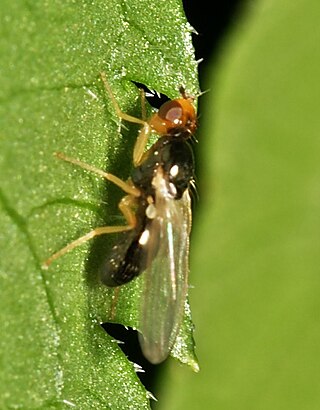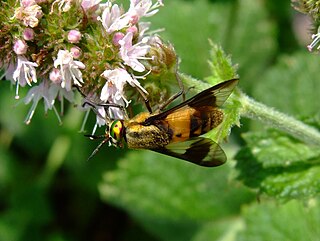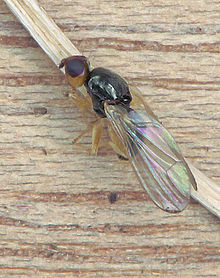
The Psilidae are family of flies. Commonly called the rust flies, at least 38 species are in four genera. The carrot fly is a member of this group. They are found mainly in the Holarctic.

Tabanus lineola, also known as the striped horse fly, is a species of biting horse-fly. It is known from the eastern coast of North America and the Gulf coast of Mexico.

Exhyalanthrax afer is a member of the fly family Bombyliidae first described by Johan Christian Fabricius in 1794.

Blera fallax, the pine hoverfly or roodkapje, is a rare species of hoverfly normally associated with mature pine trees in Northern and Central Europe.

Thelaira nigripes is a species of fly in the family Tachinidae first described by Carl Fredrik Fallén in 1817. It parasitizes moths such as Arctia caja by laying eggs in the larvae that eventually kill the host.

Prosena siberita is a species of fly in the family Tachinidae.

Chamaepsila is a genus of flies in the family Psilidae.

Philipomyia is a genus of horse fly belonging to the family Tabanidae subfamily Tabaninae.

Phyllomya volvulus is a species of fly in the family Tachinidae.

Chrysops viduatus is a species of 'horse flies' belonging to the family Tabanidae.

Terellia ruficauda is a species of fly in the family Tephritidae, the gall flies. It is found in the Palearctic. The larvae feed on Cirsium arvense.

Myopites stylatus is a species of tephritid or fruit flies in the family Tephritidae.
Acinia picturata, the sourbush seed fly, is a species of fruit fly in the family Tephritidae.

Terellia ceratocera is a species of tephritid or fruit flies in the family Tephritidae.
Hybomitra cincta is a species of horse flies in the family Tabanidae.

Chalcosyrphus (Xylotomima) piger, the short-haired leafwalker, is an uncommon species of syrphid fly found throughout North America and Europe. Hoverflies get their names from the ability to remain nearly motionless while in flight. The adults are also known as flower flies, for they are commonly found around and on flowers, from which they get both energy-giving nectar and protein-rich pollen. Larvae have been identified from sappy hollows from Larix and Pinus.

Temnostoma apiforme is a species of hoverfly. Larva of this species feed in decaying wood of deciduous trees.
Pangonius mauritanus is a species of horse fly in the family Tabanidae.
Ptecticus testaceus is a species of soldier fly in the family Stratiomyidae.
Peteina hyperdiscalis is a species of fly in the family Tachinidae.















